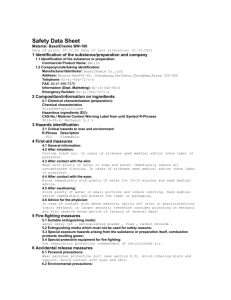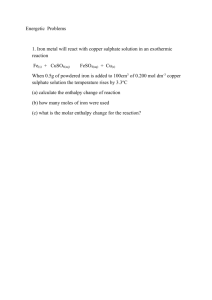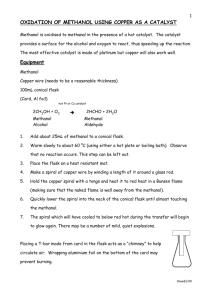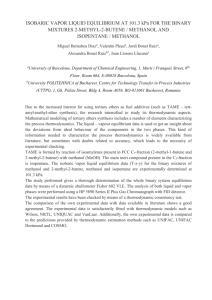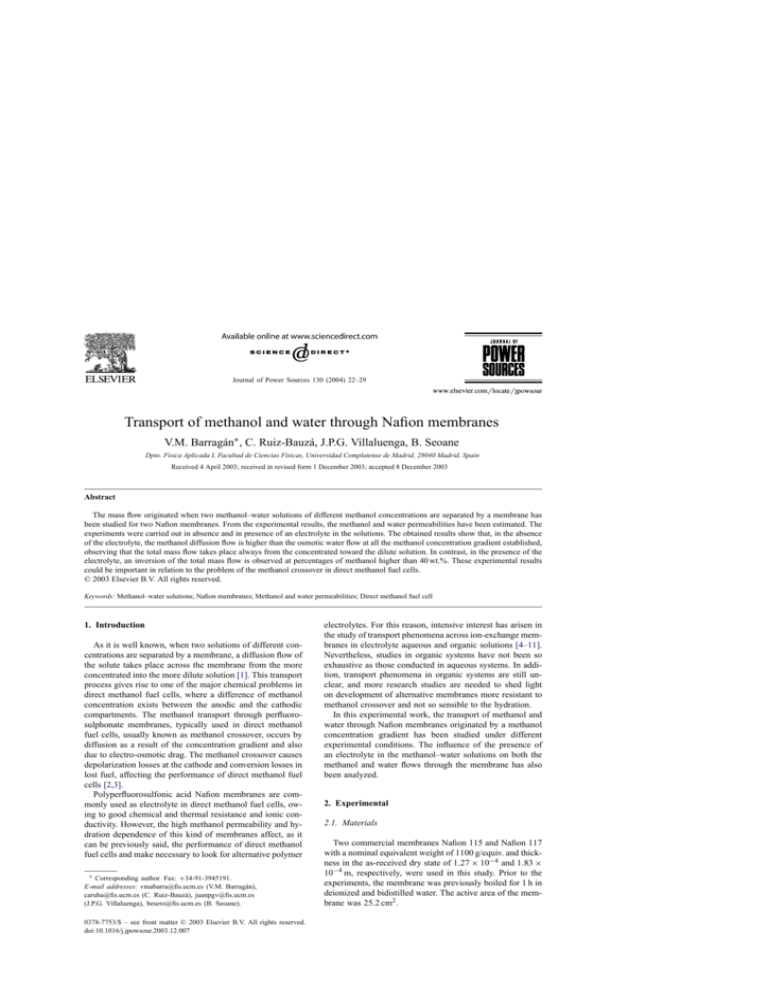
Journal of Power Sources 130 (2004) 22–29
Transport of methanol and water through Nafion membranes
V.M. Barragán∗ , C. Ruiz-Bauzá, J.P.G. Villaluenga, B. Seoane
Dpto. Fı́sica Aplicada I, Facultad de Ciencias Fı́sicas, Universidad Complutense de Madrid, 28040 Madrid, Spain
Received 4 April 2003; received in revised form 1 December 2003; accepted 8 December 2003
Abstract
The mass flow originated when two methanol–water solutions of different methanol concentrations are separated by a membrane has
been studied for two Nafion membranes. From the experimental results, the methanol and water permeabilities have been estimated. The
experiments were carried out in absence and in presence of an electrolyte in the solutions. The obtained results show that, in the absence
of the electrolyte, the methanol diffusion flow is higher than the osmotic water flow at all the methanol concentration gradient established,
observing that the total mass flow takes place always from the concentrated toward the dilute solution. In contrast, in the presence of the
electrolyte, an inversion of the total mass flow is observed at percentages of methanol higher than 40 wt.%. These experimental results
could be important in relation to the problem of the methanol crossover in direct methanol fuel cells.
© 2003 Elsevier B.V. All rights reserved.
Keywords: Methanol–water solutions; Nafion membranes; Methanol and water permeabilities; Direct methanol fuel cell
1. Introduction
As it is well known, when two solutions of different concentrations are separated by a membrane, a diffusion flow of
the solute takes place across the membrane from the more
concentrated into the more dilute solution [1]. This transport
process gives rise to one of the major chemical problems in
direct methanol fuel cells, where a difference of methanol
concentration exists between the anodic and the cathodic
compartments. The methanol transport through perfluorosulphonate membranes, typically used in direct methanol
fuel cells, usually known as methanol crossover, occurs by
diffusion as a result of the concentration gradient and also
due to electro-osmotic drag. The methanol crossover causes
depolarization losses at the cathode and conversion losses in
lost fuel, affecting the performance of direct methanol fuel
cells [2,3].
Polyperfluorosulfonic acid Nafion membranes are commonly used as electrolyte in direct methanol fuel cells, owing to good chemical and thermal resistance and ionic conductivity. However, the high methanol permeability and hydration dependence of this kind of membranes affect, as it
can be previously said, the performance of direct methanol
fuel cells and make necessary to look for alternative polymer
∗ Corresponding author. Fax: +34-91-3945191.
E-mail addresses: vmabarra@fis.ucm.es (V.M. Barragán),
caruba@fis.ucm.es (C. Ruiz-Bauzá), juanpgv@fis.ucm.es
(J.P.G. Villaluenga), besero@fis.ucm.es (B. Seoane).
0378-7753/$ – see front matter © 2003 Elsevier B.V. All rights reserved.
doi:10.1016/j.jpowsour.2003.12.007
electrolytes. For this reason, intensive interest has arisen in
the study of transport phenomena across ion-exchange membranes in electrolyte aqueous and organic solutions [4–11].
Nevertheless, studies in organic systems have not been so
exhaustive as those conducted in aqueous systems. In addition, transport phenomena in organic systems are still unclear, and more research studies are needed to shed light
on development of alternative membranes more resistant to
methanol crossover and not so sensible to the hydration.
In this experimental work, the transport of methanol and
water through Nafion membranes originated by a methanol
concentration gradient has been studied under different
experimental conditions. The influence of the presence of
an electrolyte in the methanol–water solutions on both the
methanol and water flows through the membrane has also
been analyzed.
2. Experimental
2.1. Materials
Two commercial membranes Nafion 115 and Nafion 117
with a nominal equivalent weight of 1100 g/equiv. and thickness in the as-received dry state of 1.27 × 10−4 and 1.83 ×
10−4 m, respectively, were used in this study. Prior to the
experiments, the membrane was previously boiled for 1 h in
deionized and bidistilled water. The active area of the membrane was 25.2 cm2 .
V.M. Barragán et al. / Journal of Power Sources 130 (2004) 22–29
23
Fig. 1. Sketch of the experimental device used in the experiments. B: Mass
balance; C: digital conductivimeter and thermometer; CH: chamber cell;
CP: conductivity probe; M: membrane; P: peristaltic pump; R: solution
reservoir; TCS: ambient temperature control system; TP: temperature
probe.
The materials used in the experiments were solutions of
water and methanol at different compositions. Potassium
chloride (KCl) was used as electrolyte. Pure pro-analysis
grade chemicals and distilled pure water were used. Before
measurements were carried out, the solutions were degassed
in order to prevent bubble formation during the measurement
process.
2.2. Apparatus and methodology
The experimental device used in this research is sketched
in Fig. 1. The cell consisted of two independent compartments made of PTFE of approximately 100 ml of volume
separated by the membrane. Each chamber was provided
with two orifices communicating to the exterior used as solution inlet and outlet. The solutions circulated by means of
a peristaltic pump. The circulation velocity of the solutions
was 200 ml/min. Two different solution reservoirs of about
1000 ml of capacity were used to contain the solutions in
both chambers. These reservoirs permitted to measure the
temperature and the conductivity of the solutions contained
in them by means of conductivity and temperature probes
connected to a digital conductivimeter and a thermometer.
One of the reservoirs was placed over a mass balance, which
permitted to measure the mass change in the reservoir as a
function of time. The complete unit was contained in a large
ambient thermostat. All the measurements were carried out
under isothermal conditions at 25 ◦ C.
At the beginning of the experiments, two solutions with
different concentrations of methanol were placed between
the two sides of the membrane. Initially, 800 g of an aqueous solution was placed in one of the reservoir and 800 g of
a water–methanol solution is placed in the other reservoir.
Fig. 2. Mass change as a function of time when a Nafion 115 membrane
separates pure water and a methanol–water mixture, at different weight
percentages of methanol.
Thus, the dilute solution did not contain initially methanol,
and the initial concentration of the concentrated solution coincided with the concentration difference of methanol established between both sides of the membrane at the beginning
of the experiment. When the temperature conditions were
achieved, the solutions were made circulate through the cell
and the mass change was measured as a function of time in
the reservoir containing the concentrated solution. The duration of the measurements was 6 h in all cases.
The densities of the initial and final solutions were measured by a means of a pycnometer at a temperature of 25 ◦ C.
3. Results and discussion
3.1. Nonelectrolyte methanol–water solutions
Figs. 2 and 3 show the results obtained, for membranes
Nafion 115 and Nafion 117, respectively, for the mass change
in the reservoir containing the concentrated solution as a
function of time. In all the cases studied, a decrease of
the mass in the concentrated reservoir was found, observing that the mass change increased when the percentage of
methanol of the mixture increased. Moreover, after a period
of time, a linear dependence was observed between the mass
change and time indicating that pseudosteady-state conditions prevailed during the experiment after an initial tran-
24
V.M. Barragán et al. / Journal of Power Sources 130 (2004) 22–29
Fig. 3. Mass change as a function of time when a Nafion 117 membrane
separates pure water and a methanol–water mixture, at different weight
percentages of methanol.
sient. For each methanol concentration difference, the results have been fitted to a straight line. The dotted lines in
Figs. 2 and 3 correspond to these fits. The total mass flow
per unit area A through the membrane can be defined by
Jm =
1 dm
A dt
(1)
In the pseudosteady-state region, the total mass flow through
the membrane can be estimated from the slope of the linear
straight. The obtained values are shown in Fig. 4 as a function of the initial percentage of methanol in the concentrated
chamber, which indicates in this case the concentration difference, for the two membranes used. In this figure, the total
flow had been considered positive when the mass transfer
had placed from the concentrated toward the dilute chamber.
As it can be observed, the total mass flow increases when
the methanol concentration gradient increases. In addition,
as it can be expected, the total mass flow is higher through
the membrane Nafion 115, which is the thinner membrane
[12,13].
It can be expected that the measured total mass flow, Jm ,
is due to the contribution of the methanol flow, JMeOH , for
diffusion and the water flow, Jwater , for osmosis, originated
as a consequence of the methanol concentration difference.
Thus, if the osmosis water transport is not negligible
Jm = JMeOH + Jwater
(2)
Fig. 4. Total mass flow as a function of methanol concentration difference
for the two Nafion membranes studied.
It would be important to know which are the contributions of
these two flows to the total value. This can be done if the total
mass change, m, and the initial and final methanol concentrations are known in the dilute and concentrated chambers,
as well as the initial masses of methanol and water in each
chamber. Both the total mass change and the initial mass of
the solution components in the chambers are measured in
the experiments, whereas the methanol concentration in the
chambers can be estimated as follows.
The final concentrations of methanol in the dilute chamber, c1 , and in the concentrated chamber, c2 , expressed in
weight percentages, will be given by
c1 =
(mfMeOH )1
mi1 + m
× 100,
c2 =
(mfMeOH )2
mi2 + m
× 100
(3)
where mi1 and mi2 are the initial total masses in the dilute and
concentrated chambers, respectively. From Eq. (3), the final
methanol masses in the diluted chamber, (mfMeOH )1 , and in
the concentrated chamber, (mfMeOH )2 , can be estimated, if
c1 , c2 and m are known and thus the corresponding mean
mass flows of methanol and water through the membrane.
To this purpose, the densities of the initial and final solutions were estimated under each experimental condition.
Using the data for the dependence of the density with the
concentration (wt.%) of methanol found in the literature [14]
at 25 ◦ C, it is obtained that the density of a methanol–water
solution as a function of the concentration of methanol in
V.M. Barragán et al. / Journal of Power Sources 130 (2004) 22–29
25
Table 1
Estimation of the methanol and water masses, in absolute value, interchanged between the two chambers separated by the membrane at the
end of the experiment, as a function of the initial methanol concentration
difference, for the two Nafion membranes used
Methanol concentration
difference (wt.%)
20
40
60
80
|m| (g)
Nafion 115
Nafion 117
MeOH
H2 O
MeOH
H2 O
7
14
23
31
2
1
8
9
–
18
20
36
–
10
10
16
methanol and water increase with the methanol concentration, and the mass of water is always smaller than the mass
of methanol, but not negligible. For this reason, the total flow
is always observed from the concentrated reservoir towards
the dilute reservoir, and a decrease of the mass is observed
in the chamber containing the initial methanol–water mixture. From these data, it can be estimated that the methanol
and water permeabilities are of the order of magnitude of
10−6 and 10−7 m/s, respectively, in agreement with the results obtained by other authors [15].
Fig. 5. Final methanol concentration change in the dilute (filled
symbols) and concentrated (open symbols) chambers as a function
of the initial methanol concentration difference, for the two studied
membranes—circles: Nafion 115; triangles: Nafion 117.
the mixture, c, can be fitted to a quadratic polynomial, with
a correlation coefficient of 0.9998, as
ρ (g cm−3 ) = 0.9971 − 1.349 × 10−3 c − 7.42 × 10−6 c2 (4)
Using this expression, it is possible, from the value of the
density, to obtain the corresponding values of the methanol
concentration at the beginning and at the end of each experiment. The results obtained for the two membranes are shown
in Fig. 5, in which the final methanol concentration change
in both chambers is presented as a function of the initial
methanol concentration difference. As can be expected, the
concentration of methanol increases in the chamber containing initially water, and it decreases in the chamber containing initially the mixture. The behavior is linear and similar
for the two membranes.
From the total mass change and the final methanol concentrations in the dilute and the concentrated chambers, it
is possible to estimate the quantity of water and methanol
that has passed through the membrane during the experiment. Table 1 shows these results as a function of the initial
methanol concentration difference between the chambers.
As it can be observed, a net flow of methanol is originated
from the concentrated to the dilute chamber, while a net flow
of water is originated in the opposite sense, as it can be expected in diffusion and osmotic processes. For the two membranes, the general trend is that the interchanged masses of
3.2. Electrolyte methanol–water solutions
In order to study the influence of the presence of an electrolyte on the membrane behavior, similar experiments were
carried out when the membrane separates two solutions of
equal concentration of electrolyte but different percentage
of methanol. In this case, one of the reservoirs contained initially an aqueous 10−2 M KCl solution and the other one a
methanol–water 10−2 M KCl solution of different percentages of methanol. In this way, the electrolyte concentration
was the same at both sides of the membrane but a methanol
concentration difference exited through it. The time of the
experiments was also 6 h in all the cases. Figs. 6 and 7 show,
for membranes Nafion 115 and Nafion 117, respectively, the
mass change measured as a function of time in the concentrated reservoir at different methanol concentrations.
An observation of these figures shows a fundamental difference with respect to the experiments carried out without
the presence of KCl. At 20 and 40% (w/w) methanol, a mass
decrease is observed in the concentrated chamber, indicating
that the mass total flow takes place in the same sense that in
the absence of electrolyte. It is also observed that the mass
decrease is lower when the methanol percentage increases
from 20 to 40%. For percentages higher than 40% a mass
increase is observed in the concentrated chamber, indicating
that the total mass flow occurs in the opposite sense. This
behavior is similar for the two membranes used.
In general, after an initial transient period, a linear variation of the mass change with time is observed. In the case
of 20% (w/w) methanol solution, a change in this tendency
is observed at the end of the experiments. In a similar way
26
V.M. Barragán et al. / Journal of Power Sources 130 (2004) 22–29
Fig. 6. Mass change as a function of time when a Nafion 115 membrane
separates an aqueous solution and a 10−2 M KCl methanol–water solution
at different weight percentages of methanol.
Fig. 7. Mass change as a function of time when a Nafion 117 membrane
separates an aqueous solution and a methanol–water 10−2 M KCl solution
at different weight percentages of methanol.
that in the case of nonelectrolyte solutions, in order to obtain
the total mass flow through the membranes, the experimental values were fitted to straight lines in the corresponding
region. The results are shown in Fig. 8, and as it can be
observed, the behavior is similar for the two membranes.
In order to estimate the concentration from the value of
the density, we have determined experimentally the density
of mixtures of methanol–water with a 10−2 M KCl electrolyte concentration. In this case the dependence between
density and methanol weight percentage can be also fitted
to a quadratic polynomial, with a correlation coefficient of
0.99986, as
ρ (g cm−3 ) = 0.99754 − 1.398 × 10−3 c − 6.58 × 10−6 c2
(5)
where c is the methanol concentration in the solution expressed in weight percentage.
Using this calibration curve, it is possible to obtain the
methanol concentration changes in the dilute and concentrated chambers as a function of the initial methanol concentration difference. The results are shown in Fig. 9. As
can be observed, as in the case of nonelectrolyte solutions,
the methanol concentration increases in the chamber with an
initial aqueous solution (dilute chamber) and decreases in
the chamber with the initial methanol–water mixture (concentrated chamber). However, a nonlinear behavior is now
Fig. 8. Total mass flow as a function of initial methanol concentration
difference for the two studied Nafion membranes. The concentration of
KCl electrolyte in the solutions was 10−2 M.
V.M. Barragán et al. / Journal of Power Sources 130 (2004) 22–29
Fig. 9. Final methanol concentration change in the dilute and concentrated
chambers as a function of the initial methanol concentration difference for
membrane Nafion. The concentration of KCl electrolyte in the solutions
was 10−2 M.
observed between the concentration change and the initial
concentration difference. A quadratic behavior can be considered.
From the total mass change and the value of the methanol
concentration in both chambers, the mass of water and
methanol passing through the membrane during the experiments can be estimated. The results obtained for the Nafion
115 membrane have been shown in Table 2 as a function
of the initial methanol concentration difference between the
chambers. In this case, it is observed that for 20 and 40%
(w/w) methanol, the methanol mass change is higher than
the water mass change, but this trend is opposite at higher
percentages of methanol. As in the case of the absence of
Table 2
Estimation of the methanol and water masses, in absolute value, interchanged between the two chambers separating the Nafion 115 membrane
at the end of the experiment, as a function of the initial methanol concentration difference
Methanol concentration
difference (wt.%)
20
40
60
80
|m| (g)
MeOH
H2 O
7
10
11
11
6
6
15
16
The concentration of the KCl electrolyte was 0.01 M.
27
Fig. 10. Conductivity of methanol–water 10−2 M KCl solutions at different
methanol weight percentages using two conductivity probes at 25 ◦ C: (䊊)
concentrated chamber conductivity probe; (+) dilute chamber conductivity
probe.
electrolyte, the net methanol flow is from the concentrated
chamber toward the dilute chamber, and the opposite sense
is observed for the net water flow. However, for the same
methanol concentration difference, it is also observed that,
in general, the methanol flow is lower and the water flow
is higher when the electrolyte is present in the solutions. In
this case, the methanol and water permeabilities estimated
are of the order of 10−7 and 10−6 m/s, respectively. It seems
that the presence of electrolyte favors the osmotic transfer
of water and reduces the diffusion of methanol through
the membrane at the higher percentages of methanol. This
fact may be important in order to decrease the methanol
crossover, as well as the dehydration of the membrane in a
direct methanol fuel cell.
In order to follow the time variation of the concentration of
methanol in both chambers, the conductivity of the solutions
have been measured as a function of time during the experiments for Nafion 115 membrane. Previously, we have determined experimentally the conductivity of methanol–water
10−2 M KCl solutions at different methanol percentages using the same two conductivity probes used in the experiments. Fig. 10 shows the obtained results as a function of
the methanol content of the solutions. These results showed
that a quadratic dependence can be considered between the
conductivity and the methanol weight percentage on the solution, c. The dashed line in Fig. 10 corresponds to these
28
V.M. Barragán et al. / Journal of Power Sources 130 (2004) 22–29
Fig. 11. Methanol concentration in the dilute chamber vs. time at different methanol concentration differences for membrane Nafion 115 when
electrolyte solutions are used.
fits, obtaining a correlation coefficient higher than 0.999.
The empirical curves found were
σconcentrated (S) = 1385 − 26.38c + 0.2073c2 ,
σdilute (S) = 1392 − 26.62c + 0.2093c2
(6)
observing that the conductivities of the system have a minimum value at around 60% (w/w) methanol. The diminution observed in the 0–60% range of composition is due to
the decrease in the dielectric constant of the solvent with
increasing proportion of methanol and, so, to the decrease
in the ability of the solvent to dissolve the electrolyte [16].
Similar behavior has been described for the equivalent conductivity of KCl in methanol–water mixtures, with a minimum at about 80 mol% alcohol [17] and for methanol–water
KCl and NaCl solutions using other methods [18].
Using these calibration curves it is possible, from the experimental dependencies of the conductivity with time, to
estimate the variations of the methanol concentration in both
chambers. The results, for membrane Nafion 115, are shown
in Figs. 11 and 12, for dilute and concentrated chambers,
respectively, at different initial methanol concentration differences. As can be observed, the variation of the concentration of methanol with time is linear.
As it has been shown, the methanol content in both chambers at the end of the experiments has been estimated from
conductivity and density measurements. It would be interest-
Fig. 12. Methanol concentration in the concentrated chamber vs. time at
different methanol concentration differences for membrane Nafion 115
when electrolyte solutions are used.
ing to compare the reliability of both methods. Table 3 contains the final methanol percentage changes in both chambers obtained by using the two methods. As can be observed,
the results obtained by both methods are similar, within the
experimental error, in the case of the concentrated chambers.
For the dilute chamber, the values are also similar, but the
differences are slightly higher. It may be due to the calibration curves that are valid when the concentration of the salt
is the same for all the methanol–water mixtures. However, it
is possible that, although at the beginning of the experiment
the salt concentration is the same in both chambers, when
solvent is passing through the membrane, the concentration
Table 3
Methanol percentage change in the dilute and concentrated chambers at
the end of the experiment, as a function of the initial methanol percentage
difference between the two chambers
Methanol percentage
difference (wt.%)
20
40
60
80
Methanol percentage change (wt.%)
Dilute chamber
Concentrated chamber
I
II
I
II
–
0.8
1.0
1.2
0.8
1.2
1.5
1.5
–
−1.0
−1.5
−1.6
−0.6
−1.1
−1.6
−1.7
I: from conductivity measurements; II: from density measurements.
V.M. Barragán et al. / Journal of Power Sources 130 (2004) 22–29
of electrolyte may change. Taking into account that the mass
flow is small with respect to the total mass of the chamber,
it is expected that the variation of the electrolyte concentration will be small. However, this possible variation may
affect more the determination of the conductivity, where the
salt concentration has a high influence than that in the determination of the density. The results obtained show that
this influence seems to be higher in the dilute concentrated,
in such a way that the influence will be more important at
smaller percentages of methanol.
The different behavior of the system observed in presence
and in absence of an electrolyte in solution may be due to
the presence of electrolyte in the compartments, since the
rest of the experimental conditions are similar, as a consequence of the K+ -form of the Nafion membrane. Tricoli [19]
observed that the methanol permeability could be reduced
when a Nafion 117 membrane was doped with Cs+ cations
at room temperature. This result was explained on the basis of alterations produced by the presence of cesium in the
membrane microstructure, which reduces the hydrophilic
domains though methanol diffuses primarily. Other authors
have also observed the influence of the cation-form of the
membrane in its transport properties [20,21]. In this sense,
when the salt is added to the solutions in contact with the
membrane, the presence of K+ in the membrane would cause
a reduction of methanol permeability, as is observed.
On the other hand, the increase of the water flow observed
when electrolyte solutions are used may be due to the diffusion of methanol and water originated by the methanol concentration difference gives rise an electrolyte concentration
gradient. This fact would originate an osmotic water flow in
the same sense that those due to the methanol concentration
difference and thus to a higher water transfer than that in
absence of electrolyte. One interesting topic would be the
analysis of the cation nature of the electrolyte in the process.
Further works are in progress in this sense.
concentration gradient established, observing that the total
mass flow takes place always from the concentrated toward
the dilute solution. In the presence of the electrolyte, an
inversion of the total mass flow is observed at percentages
of methanol higher than 40 wt.%.
This behavior could be due to the fact that the presence
of electrolyte cation in the structure of the membrane causes
a reduction of the methanol permeability and an increase of
the osmotic water effect as a consequence of the electrolyte
concentration differences established between both sides of
the membrane during the process.
Acknowledgements
Financial support from Ministerio de Ciencia y Tecnologı́a of Spain under Project BFM2000-0625 is gratefully
acknowledged.
References
[1]
[2]
[3]
[4]
[5]
[6]
[7]
[8]
[9]
[10]
[11]
[12]
[13]
[14]
4. Conclusions
The mass flow originated when two methanol–water solutions of different methanol concentration are separated by
a membrane has been studied, for two Nafion membranes,
in absence and in presence of an electrolyte in the solutions.
The experimental results show that, in all cases, a
methanol diffusion takes place across the membrane from
the more concentrated solution to the more dilute solution,
and a water transport takes place in the opposite sense.
In the absence of the electrolyte, the methanol diffusion
flow is higher than the osmotic water flow at all the methanol
29
[15]
[16]
[17]
[18]
[19]
[20]
[21]
F. Helfferich, Ion Exchange, Dover, New York, 1995.
H.P. Hogarth, G.A. Hards, Platinum Met. Rev. 40 (1996) 909.
B. Gurau, E.S. Smotkin, J. Power Sources 112 (2002) 3339.
M.W. Verbrugge, J. Electrochem. Soc. 136 (1989) 417.
M.W. Verbrugge, R.F. Hill, J. Electrochem. Soc. 137 (1990) 886.
T.A. Zawodzinski, T.E. Springer, F. Uribe, S. Gottesfeld, Solid State
Ionics 60 (1993) 199.
T.A. Zawodzinski, J. Davey, J. Valerio, S. Gottesfeld, Electrochim.
Acta 40 (1995) 297.
K. Scott, W. Taama, J. Cruickshank, J. Power Sources 65 (1997) 159.
E.K. Unnikrishnan, S.D. Kumar, B. Maiti, J. Membr. Sci. 137 (1997)
133.
T. Okada, G. Xie, O. Gorseth, S. Kjelstrup, N. Nakamura, T. Arimura,
Electrochim. Acta 43 (1998) 3741.
J. Cruickshank, K. Scott, J. Power Sources 70 (1998) 40.
D.H. Jung, C.H. Lee, C.S. Kim, D.R. Shin, J. Power Sources 71
(1998) 169.
V.M. Barragán, A. Heinzel, J. Power Sources 104 (2002) 66.
J. D’Ans, H. Surawsky, C. Synowietz, Densities of liquid systems
and their capacities, in: Numerical Data and Functional Relationships
in Science and Technology. Group IV. Macroscopic and Technical
Properties of Matter, vol. 1, Springer, New York, 1977.
P.S. Kauranen, E. Skou, J. Appl. Electrochem. 26 (1996) 909.
V.S. Bagotzky, Fundamental of Electrochemistry, Plenum Press, New
York, 1993.
J.O’M. Bockris, A.K.N. Reddy, Modern Electrochemistry, vol. 1,
Plenum Press, New York, 1973.
V.M. Barragán, C. Ruiz-Bauzá, J. Colloid Interf. Sci. 247 (2002) 138.
V. Tricoli, J. Electrochem. Soc. 145 (1998) 3798.
R.F.D. Costa, J.Z. Ferreira, C. Deslouis, J. Membr. Sci. 215 (2003)
115.
M. Legras, Y. Hirata, Q.T. Nguyen, D. Langevin, M. Métayer, Desalination 147 (2002) 371.





